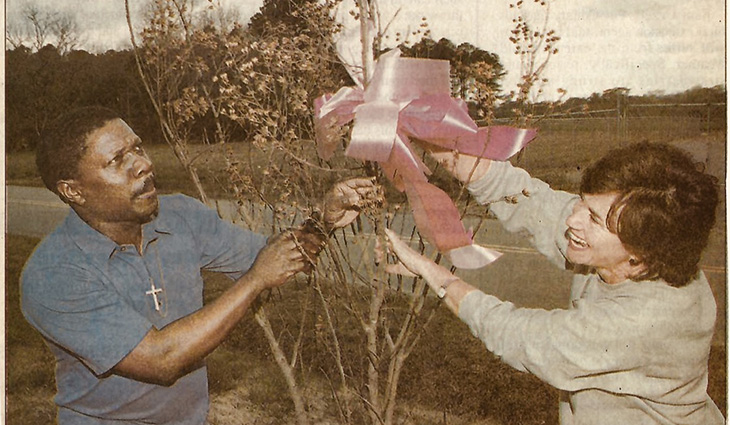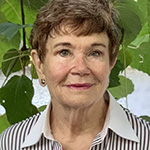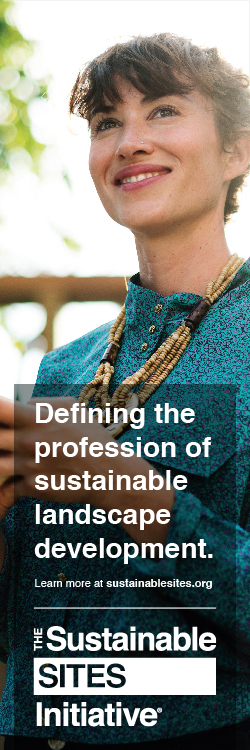Milestones & New Members
8/8/2023Leave a Comment

Madeline Sutter and Charles with a Crepe Myrtle. Image provided by Madeline Ann Sutter, ASLA
40 YEARS+
North Carolina Chapter

Madeline Ann Sutter, ASLA
Where are you from and how long have you been a landscape architect? Chicago, Ill until age 1. Fort Atkinson, Wisconsin until age 22. St. Louis, Missouri until 1989 Oriental, North Carolina. 1989-present Landscape Architect since 1966. How did you begin your career journey in Landscape architecture? My grandfather from Alsace who lost his chain of shoe stores in Chicago and proudly enrolled in welding in Wisconsin to support his family. I have his report cards. Daughter of horticulturally active father who regarded me as a person incidentally female. I would make regular trips to his lighting fixture factory with explanations of all aspects of employees, materials, work and production. My Grandfather and father researched building in the town library and built a little house as a test followed by our larger family house. Pure mathematics University of Wisconsin, 1965, member of Gemini capsule simulation team: 6Degrees of Freedom, Pitch, Yaw, Roll, x, y, z, McDonnell Aircraft, St. Louis, MO, Volunteered at MOBOT, redesign St. Louis Herb Society Garden, in St. Louis, MO • 1971 Peter Raven came from Stanford to be new Director, gave me all private business, hired Chief of Horticulture (newly from Filoli Gardens, CA) to consult.. In 1980 - LA community in St. Louis open and inclusive. I was nominated for full Membership in ASLA by the Dir. of St. Louis County Parks & Rec. and St. Louis Chapter Trustee as a seasoned practitioner. During those early years and I subcontracted for other firms even so much as to drive around special clients of theirs and show trees........."talk nice to them, Madeline". It was a purely pleasurable non compete. Great fun. Any time I had a question I could move a job into any other firms to be taught by the experts. They came to know me well. Until I refused to use black mortar on the pink cobbles Austin Tao, FASLA specified and used mortar to complement.. Between 1966 - 1989 I worked at Inside/Outside with 30 employees was Gifted a logo by friend, Professor Patrick Kennedy of 7up logo designs, a St. Louis company. In 1989 Sold my firm and business plan in St. Louis when we moved to NC to race and cruise an ocean-going sailboat. Noteworthy of my employees in St. Louis. I came to hire only Washington University Graduate Students with NO background in the landscape industry. We all worked hard and we all made money. I thank my parents for my inability to discriminate. It seems to get in the way for everyone who does. I hired the best and they worked hard. If they had to learn, they worked hard to learn, keep up and excell. What do you think is the most important issue facing landscape architects today? Truth from which all good decisions are made. For each client I ask 3 questions: What do I have? What do I want? What change can I reasonably make? What have you gained by being a member of ASLA for 42 years? Good health and happiness in that my passion is my work. I've never worked a day in my life. Most landscape architects die with their boots on and. DO NOT PLANT MUCH GRASS! I am known in Oriental as the Tree Lady, coined by the Mayor. What would you share with others as a reason for belonging to ASLA as a member? Collegiality. Belonging. We are all different and yet have unity in our profession. What would you share with those new to the profession of landscape architecture? Keep learning. Be curious. Wondered about big ware in site furnishings, clay at Penland. Asked figurative sculptor Arthur Gonzales if one's face is painted does one look out at the world in a different way? What is your favorite project in your career and why? I created the Tree Board in Oriental, NC and won $50,000 over a period of 4 years matching the grants with my own hours and expenses, receiving no money in payment. My last project is my favorite of all time. When I spoke at the Southeastern Forestry Conference for the US Forest Service about my tree program at the Royal Omni in New Orleans, the crape myrtle expert showed me what he believed to be the most successful planting on the Bayou St. John. Random colors and shapes of Crape Myrtles, forgiving, not all in a row, mildew and disease resistant. I told them if they would give me the money I would do that in Oriental, (NC).. I did! All up and down the Main Drag on a NC Highway 55.
When they were planted the New Bern Sun Journal asked for a photo. (shown above). I chose the most active homeowner to adopt the trees (we have no water truck here). Charles and I here, ran in the newspaper on Easter Saturday, April 6,1996. The blue shirt and cross are staples in Charles wardrobe. Just so happened to fit. What in your view is the most important thing that landscape architects provide? Acceptance and kindness of clients, citizens, children even on the way to what is the question (s) and about which topic do they care most? Listen. Draw them out. Practice active listening skills. Then be READY and INFORMED. Is there anything else you would like to share to commemorate your 42 years with ASLA? I did more and received more as a volunteer than any paying commission. 2003 Led Educational tour of the Garden District, New Orleans for National Meeting. Served as Residential Landscape Architecture Group as Chair, secured Eric Groft to speak at New Orleans National Meeting. Invitation to entire Residential PI Group to Les Chat Vents by Francis Cabot. If I had not created TREES FOR ORIENTAL, NC - a long range plan for public trees, an original work with sections and foldouts, I would not have been recruited for graduate school. 1996-1999 NCSU College of Design, Master of Landscape Architecture and Industrial Design with honors. During which time I would created and illustrated the handbook 1998 copyright, TREES FOR SMALL TOWNS, used by NSCU and the NC Urban Forestry Department, to be distributed free of cost. My MLA thesis is Ma: An Investigation into the Making of Exterior Meditative, Physical and Sequential Space using the Japanese Garden as an example. I have traveled extensively in Japan. The harmonics and pure mathematics from my early days inform my designs. I put is simply to clients: think Beethoven. da da da daaaaa. Do this in your landscape. I can prove if the harmonics of the garden's space are no felicitous the garden will not be maintained. I was a member of the Ocracoke Island charette focussing on that to do for safety and preservation of the community.
30 YEARS+
Washington Chapter

Daniel M. Winterbottom, FASLA
Where are you from and how long have you been a landscape architect? I grew up in the marvelous state of New Jersey and have lived for the last 33 years in Seattle, WA. I have been a Landscape Architect for just over 30 years. How did you begin your career journey in Landscape architecture? In my formative years I deferred my formalized secondary education and made the decision to drop out of college following my freshman year and to undertake an apprenticeship with an artist/craftsman. After two years of intensive learning, I moved to NYC to focus on painting and printmaking. I resumed my undergraduate education upon entering the School of the Museum of Fine Arts, Boston in 1979 as a painter, but soon became engaged in conceptual and environmental art and my work left the studio confines out into the public domain, often incorporating nature, spatial deign, and human psychology. After completing my degree, I worked in construction, continued to make art, and at the age of 30, my girlfriend, now my wife suggested the field of landscape architecture as a space where my many interests, art, social advocacy, and nature could be melded. I applied to many schools, and ultimately remained in Boston, only to graduate in 1988 in the middle of a recession. I was laid off at which point change seemed like a good option and I relocated to Seattle and good fortune greeted me with a job at The Portico Group. 3 years later I was offered a position in academia a place I never had envisioned I would be my career which along with my own practice has been my life for 28 years. What do you think is the most important issue facing landscape architects today? Clearly climate change is the most urgent and critical challenge we are facing today. Another significant and equally urgent issue is the declining mental health challenges that many, especially young people, face today. The use of nature as a therapeutic intervention, is an important means to address this current public health crisis. Incorporating sustainable design principles in all our projects requires thoughtful application and is an essential ethics we must bring to all our projects. A loaming issue demanding our attention is the role of AI in our profession and what this will mean to the culture of design and landscape perception. What have you gained by being a member of ASLA for 30 years? For me ASLA has offered many opportunities for growth and development. First, was the unique opportunity to write for LAM under the mentorship of editor Bill Thompson who encouraged me to write about my work in an honest and probing manner, while testing and challenging me to hone and refine my writing and communication skills. Second, has been being a part of the Therapeutic Network, led for many years by Naomi Sacks that introduced me to fellow sprits and leaders practicing in this focus area of design and increased my awareness about many new projects while engaging us all in many enlightening discussions and debate. Third was is the opportunity to participate over the last several decades in the ASLA awards programs which has been exceptionally rewarding. To receive an award from my mentors and role models, and later my peers, has been deeply moving personally and a significant benefit to my academic career. Finally, to be admitted as a ASLA fellow early in my career was one of the most significant professional highlights. To be honored for my work, done for many years in relative isolation and often perceived to be on the fringes of the profession was particularly meaningful. To be recognized for our work with marginalized populations, our model of community participatory design uses an experiential learning model came as a welcome, though unexpected endorsement of my quest for a meaningful application of my skills and beliefs within our discipline. What would you share with others as a reason for belonging to ASLA as a member? The connections and friendships formed, and expansion of one’s network was particularly important for me as a younger aspiring landscape architect. I was privileged to form mentorships with people I had deeply respected through activities sponsored by ASLA and these also expanded my community of peers through attendance at meetings, special focus networks, through state ASLA associations and in preparing presentations and workshops for the conferences. What would you share with those new to the profession of landscape architecture? ASLA represents a diverse field, a collection of many interests and perspectives held by its members. It offers younger, newer members a space to find themselves through the relationships fostered with other members. I remember my earliest presentations at the annual conferences. I came to these gatherings with a strong interest in social justice, and frankly felt immense trepidation that few attendees would be interested in my work, ideas, or perspective. After giving my first, nerve racked presentations I was often warmed by the reception, and the connections made with other members who shared my perspectives, many of whom became lifelong colleagues. While certainly intimidating, participating in workshops, seminars and the like can assist you in finding your own path, your chosen communities, your future collaborators, something both reassuring and reinforcing to the novice I once was. I found that those I idolized, were in fact approachable and many appreciated my interest and gave generously of their time. Today the issues we face seem more critical, more daunting in their immediacy and consequential impacts than ever before. The wide crevasses that divide our communities require sensitivity, humbleness, strength, and honesty. The role of landscape architects to bridge animosities and bring communities together through nature-based design is more critical than ever, and yet still today activism and advocacy are roles that landscape architects must also embrace and reveal through our work. As you grow, mature, and excel, remember that access to nature should be a right, not a privilege. It is an essential component of our public and human health. Equity is as important as design, serving the most marginalized is more essential than serving the most privileged. Be the change maker in both how and why you practice, and in who you serve. What is your favorite project in your career and why? Hah well can I list two? The first was a project done with my students in the mid 1990s during the height of the AIDS/HIV crisis. The community served was Incarnation Children’s Center, a foster home and hospice for children with AIDS. At that time children with HIV/AIDS in NYC couldn’t visit public parks due to the stigmatization and ostracization, and most had lost their parents to heroin and/or AIDS. The trauma was enormous, but often hidden from others. The garden became a place of solace, a safe place where the illness didn’t define them, and childhood, however short lived, was possible. The residents participated in the design, and those who were able to do so also in the construction. Many of us became both friends and parents to the residents, navigating the cultural challenges of class, race, and the phobias of AIDS. Many students carried children with mobility challenges, and cuddled with them when life became overbearing, or a doctor’s visit diminished their hope. The garden was a continuing delight and comfortable space. Simple interventions, a modest grass rolling mound, a karaoke stage, their own windowsill planter, or rocking with a caregiver in a bench swing offered momentary escape, a bit of normalcy, a chance to live the adventures and curiosity of childhood, now possible despite the severity of the illness. It was one of my first projects where the therapeutic power of nature became so obvious, so necessary, so valuable. The Zalishchyky Memorial project was a memorial for a Ukrainian Jewish cemetery in that had been obliterated, no evidence of its former existence existed., The site, 4 acres, was almost entirely paved over except for a patch that has ironically escaped development. It was still a barren piece of land, all evidence of the deceased removed, yet the ground remained, unloved but still sacred, though unclaimed. Many of the stone markers had been appropriated for use in newer buildings, some used as drain covers and others found in streams or kept as garden ornaments were returned. These 40 broken stones were all that was left of thousands of stones once marking an individual within the former cemetery. The purpose was to honor the memories and convey its historical purpose as a sacred place. This project challenged me to explore eraser and the role of narrative to convey both a story and a soul. How to reveal the experience of violence that destroyed a place, while offering condolence, prayer, and acknowledgment to those who suffered such a massive loss, even though very few Jews remain in Ukraine. To create a ritual, despite the disappearance of the ritual elements and create an experience of healing and responsibility. This project had many challenging layers, obligations, and risks. It tested my design abilities and it’s not clear if I succeeded, due to the war it was not built. The process and those questions that emerged were some of the richest I have contemplated through my work. What in your view is the most important thing that landscape architects provide? Hope, and I know this sounds pat and touchy/feely, but much of my work is intentionally focused on populations who have been traumatized in very real ways, armed conflict, political terror, natural and unnatural disasters, sexual and phycological abuse and others. Many have lost faith in humanity, in themselves, in life and the act of bringing nature into their lives, providing access into a safe place, ponder the wildlife and beauty of the plants is restorative spiritually psychologically, and physiologically, and to reestablish a sense of themselves. My most recent work, generously funded by Landscape Architecture Foundation explored the role of nature in prisons has been extraordinary illuminating. The stories that emerged including one about an individual that sought solitary confinement because there, and only there he, through a small crack in the wall, could view a small piece of nature. Another story was of a Syrian refugee who experienced sexual violence and the loss of her entire family. When she first came to the garden of healing in Arnup, Sweden she didn’t speak. Six months later, after spending time with sensitive horticultural therapists she regained that capacity and developed continuing coping skills through her plant-based interactions. Or of an individual that after spending 33 years on death row rejoined the general population and found an amazing garden built by incarcerated individuals under the tutelage of a landscape designer. Within a month he memorized every plant and symbol, their metaphorical meanings and relevance to one’s spiritual journey. His, and many of his peer’s pathways towards restorative justice been supported and enhanced through their revelations gained through plant and social interactions in the garden. Their renewed belief in themselves, aspiration for a new life, and a life with others has been transformative. This is what landscape architecture can do. With alarming rates of mental health challenges facing so many young people, an aging population that is experiencing isolation and abandonment, and those who should be at the peak of their productivity but face uncertain futures, the need for places of healing and redemption has never been more urgent. This focus is not exclusive of ecological design nor addressing of climate change but is a critical objective for our time and should be an intentional component of our design practices. Is there anything else you would like to share to commemorate your 30 years with ASLA? I’m gratified to witness changes over 30 years in this profession while understanding that progress is still needed to increase the diversification of the profession. While the makeup of the profession has sifted, the cost of education has risen and many from families without significant means are pausing about entering a profession that is relatively modest in its renumeration. Helping those who are interested but unable to afford the costs is important and scholarships/low interest loans critical to supporting race and class diversification in the profession. LAF offers significant opportunities for support, and some academic departments have limited endowments, and yet the need is greater than the resources available. It is important for those of us in the profession to be generous and create opportunities for increased diversity among our students, and ultimately the discipline.
50 YEARS
Texas Chapter
Michael Murphy, ASLA
40 YEARS
Florida Chapter
Beth Levin, ASLA
Michigan Chapter
Daniel Zwier, ASLA
New Jersey Chapter
Benton Grant, ASLA
Pennsylvania/Delaware Chapter
Matthew Spong, ASLA
Washington Chapter
Terrance Reckord, FASLA
30 YEARS
Arizona Chapter
Janice Cervelli, FASLA
Florida Chapter
Larry Washmuth, ASLA
Georgia Chapter
Danna Cain, ASLA
Louisiana Chapter
Chad Danos, FASLA
St. Louis Chapter
L. Andrew Franke, ASLA
Virginia Chapter
Warren Byrd, FASLA
Washington Chapter
Daniel Winterbottom, FASLA (see above story)
New Members
California Southern
Lorenzo Rodarte, ASLA
Illinois Chapter
Emmalucia Quiroa-Crowell, Associate ASLA
Indiana Chapter
Chad Bruik, Affiliate ASLA
Thomas Jones, ASLA
Michigan Chapter
Jeffery D. Bell, ASLA
Minnesota Chapter
Mya Kesler, ASLA
North Carolina Chapter
Christopher Logan Thomas, Associate ASLA
Pennsylvania/Delaware Chapter
Christopher Hoffman, Affiliate ASLA
Potomac Chapter
Haoyue Wu, Associate ASLA
Texas Chapter
George Brandon Zambrano, Associate ASLA
Virginia Chapter
Alyssa Ratcliff, Affiliate ASLA
Huaxuan Wu, ASLA
Washington Chapter
Lindsay Warren Hawks, ASLA
Matthew McCreary, ASLA
Wisconsin Chapter
Joe Maurer, ASLA
International
Sampson Kar Kei Mok, International ASLA
Student
Joseph Bondi, Student ASLA
Kyrah Martin, Student ASLA
Jesse Anderson, Student ASLA
Jackson Bokenkamp, Student ASLA
Jordon Drumgoole, Student ASLA
Danielle Gloisten, Student ASLA
Isabella Guerrero, Student ASLA
Student Affiliate
Phuong-Thao Nguyen, Student Affil ASLA
Student International
Joan Koola, Student Intl ASLA


.png)
.png)
.png)
.png)
.png)
(1).png)

